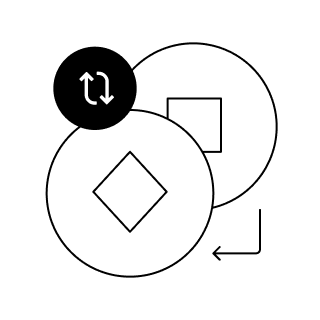How to buy Bounce (AUCTION) in 3 steps
Whether you’re new to crypto or an experienced trader, you can buy crypto using the OKX Exchange.
Step one
Get OKX
If you haven’t already, download the OKX app and sign up to get started.
Step two
Fund your account
Make a deposit using PayNow.
Step three
Choose your crypto
Select the crypto you’d like to buy from the 3,000,000+ available on OKX.
What’s Bounce (AUCTION)? How can I buy it?
<h2>What is Bounce?</h2>
<p>Bounce (token: AUCTION) is a decentralized auction platform designed to facilitate the creation, listing, and execution of a wide range of auction formats for token sales, NFTs, and other digital assets. It aims to bring fair price discovery and efficient capital allocation to Web3 by providing on-chain, programmable auction primitives that projects and users can customize to their needs. Bounce launched in 2020 and has since expanded into a suite that includes:</p>
<ul>
<li>Bounce Finance (on-chain auction platform for tokens and NFTs)</li>
<li>Bounce Launchpad (token launches using multiple auction mechanisms)</li>
<li>Bounce V3/V4 protocols and SDKs (developer tooling)</li>
<li>NFT marketplaces and sealed-bid auctions</li>
<li>Cross-chain deployments on networks such as Ethereum, BNB Chain, and others</li>
</ul>
<p>The native utility and governance token, AUCTION, is used for governance proposals, fee discounts or payments in protocol activities (depending on the product version), and incentives within the ecosystem. The overarching vision is to make auctions a core primitive in DeFi and NFT markets, enabling trust-minimized distribution and fair participation beyond first-come, first-served models.</p>
<p>Note: Bounce was initially associated with BOT (an early governance token) before consolidating economic and governance functions around AUCTION.</p>
<h2>How does Bounce work? The tech that powers it</h2>
<p>At its core, Bounce is a suite of smart contracts implementing multiple auction types, each designed to handle different market needs. Projects can configure parameters—such as reserve price, maximum/minimum allocation per participant, whitelists, time windows, and settlement rules—and deploy auctions trustlessly. Key components include:</p>
<ul>
<li>
<p>Smart contract architecture</p>
<ul>
<li>Auction factories: Contracts that instantiate new auctions with standardized interfaces and audited logic.</li>
<li>Auction types as modules: Fixed-price, Dutch, English, sealed-bid, batch auctions, and lottery/raffle-style distributions are supported through modular contracts. This allows developers to select or extend the mechanism that best fits their distribution goals.</li>
<li>Settlement and allocation contracts: Handle bid validation, winner determination, refunds, and token distributions with on-chain verifiability.</li>
<li>Fee routing and treasury: Protocol fees from auctions are collected and routed to the DAO treasury or burned/staked mechanisms per version.</li>
</ul>
</li>
<li>
<p>Auction mechanisms commonly supported</p>
<ul>
<li>Fixed-price sale: Tokens/NFTs are sold at a set price until inventory is exhausted or the sale ends.</li>
<li>Dutch auction: The price starts high and falls at scheduled intervals until buyers clear the supply; good for efficient price discovery and discouraging gas wars.</li>
<li>English auction: Bidders place ascending bids; the highest bidder at closing wins, often used for NFTs or scarce items.</li>
<li>Sealed-bid auction: Bids are submitted privately (commit phase) and revealed later (reveal phase) to reduce strategic bidding and front-running.</li>
<li>Batch auction: Bids are aggregated and cleared at a single market-clearing price, providing uniform pricing for all successful participants.</li>
</ul>
</li>
<li>
<p>Security and audits</p>
<ul>
<li>Bounce has undergone audits from reputable firms for various versions of its contracts. Users should always check the latest audit reports and repository tags for the specific deployment they intend to use, as auctions are highly configurable and often deployed across multiple chains.</li>
<li>Many auctions use commit–reveal schemes, off-chain signing, or Merkle proofs for allowlists to mitigate front-running and Sybil risks. Sealed-bid designs also reduce MEV exposure compared to open ascending auctions.</li>
</ul>
</li>
<li>
<p>Cross-chain deployment and tooling</p>
<ul>
<li>Bounce operates across multiple EVM-compatible chains to reduce fees and broaden access. Bridges or native token distributions per chain are supported by deploying the same auction primitives on each network.</li>
<li>SDKs and APIs let developers integrate auctions into dApps, launchpads, and marketplaces, enabling custom UIs and whitelisting flows.</li>
<li>Oracle and price feeds: Depending on auction type, auctions can be designed to be oracle-free (price discovered endogenously) or reference oracles for guardrails like price bands.</li>
</ul>
</li>
<li>
<p>Governance and token utility</p>
<ul>
<li>AUCTION token holders can participate in protocol governance (parameter changes, new auction types, fee schedules).</li>
<li>Depending on product iteration, AUCTION may be used for platform fees, staking for incentives, or gaining access to premium features/allocations. Always consult current documentation, as utility evolves with protocol upgrades.</li>
</ul>
</li>
<li>
<p>UX and anti-bot measures</p>
<ul>
<li>Whitelists, KYC (where applicable), per-address caps, and randomized settlement are used to promote fair access and reduce gas wars.</li>
<li>Batch submissions and off-chain order aggregation (settled on-chain) can help keep costs predictable while retaining on-chain transparency.</li>
</ul>
</li>
</ul>
<h2>What makes Bounce unique?</h2>
<ul>
<li>Breadth of auction formats: Few Web3 platforms support as many institutional-grade auction mechanisms within one protocol. This versatility attracts both DeFi token launches and high-value NFT sales.</li>
<li>Fair price discovery: Dutch and batch auctions in particular have proven useful for mitigating hype-driven gas spikes and enabling more equitable access compared to FCFS launches.</li>
<li>Modular, composable design: Developers can plug auction modules into their own dApps and tailor parameters for token distribution, treasury sales, NFT mints, or even real-world asset token auctions.</li>
<li>Multi-chain reach: By supporting several EVM chains, Bounce helps issuers reach communities where gas fees and user preferences differ.</li>
<li>Provenance and transparency: On-chain settlement provides verifiable outcomes—who bid, how much, and at what clearing price—building trust with participants.</li>
<li>Governance-led evolution: AUCTION holders steer protocol direction, enabling responsive iteration on fees, security practices, and new auction types.</li>
</ul>
<h2>Bounce price history and value: A comprehensive overview</h2>
<ul>
<li>Token: AUCTION (ERC-20)</li>
<li>Supply: AUCTION has a capped maximum supply (consult the latest tokenomics and explorer data for precise figures and vesting schedules).</li>
<li>Market history: Since its launch, AUCTION has exhibited significant volatility, typical for utility/governance tokens in early-stage DeFi infrastructure. Price has cycled with broader crypto market conditions, product rollouts, and demand for launchpad and NFT auction services.</li>
<li>Drivers of value:
<ul>
<li>Protocol usage: More auctions, particularly high-profile token/NFT sales, can drive fee generation and utility demand.</li>
<li>Governance influence: As key parameters and new modules are governed by token holders, perceived governance value can influence pricing.</li>
<li>Cross-chain expansion and partnerships: Integrations with major ecosystems, participation by reputable projects, and successful high-demand sales can be catalysts.</li>
<li>Token economics: Emissions, staking incentives, fee capture/burns, and treasury management affect long-term value accrual.</li>
</ul>
</li>
</ul>
<p>Because crypto markets are highly dynamic, always check up-to-date sources (market data aggregators, on-chain analytics, and the official Bounce documentation) for current circulating supply, market cap, and price performance.</p>
<h2>Is now a good time to invest in Bounce?</h2>
<p>I cannot provide financial advice, but here are the factors an informed investor might evaluate:</p>
<ul>
<li>
<p>Fundamental traction</p>
<ul>
<li>Protocol metrics: Number and volume of auctions, unique participants, and fees generated across chains.</li>
<li>Client mix: Are reputable projects using Bounce for token launches or NFT sales? Are auction outcomes perceived as fair and efficient?</li>
<li>Roadmap progress: New auction types, SDK improvements, cross-chain deployments, and security audits.</li>
</ul>
</li>
<li>
<p>Token economics and governance</p>
<ul>
<li>Utility alignment: How directly do protocol fees and usage translate into value or demand for AUCTION?</li>
<li>Supply dynamics: Vesting, unlock schedules, treasury policies, and any staking/burning mechanisms.</li>
</ul>
</li>
<li>
<p>Competitive landscape</p>
<ul>
<li>Alternative launchpads and auction platforms (e.g., other Dutch/batch auction tools, NFT auction houses) and their market share.</li>
<li>Differentiators like sealed-bid privacy, anti-bot tech, and customizable modules.</li>
</ul>
</li>
<li>
<p>Market conditions and risk</p>
<ul>
<li>Macro crypto trends: Liquidity cycles, regulatory developments, and L2 adoption can influence demand for auctions.</li>
<li>Smart contract risk: Even audited contracts carry risk. Review audit reports and consider isolating risk per chain.</li>
<li>Liquidity and volatility: AUCTION can experience sharp swings; position sizing and risk controls are essential.</li>
</ul>
</li>
</ul>
<p>Practical steps:</p>
<ul>
<li>Read the latest Bounce documentation, audits, and governance forum posts.</li>
<li>Review on-chain activity dashboards for Bounce-related contracts.</li>
<li>Compare recent auction outcomes and user feedback with competing platforms.</li>
<li>If participating in auctions, test on a small scale first to understand mechanics and fees.</li>
</ul>
<p>Bottom line: Bounce addresses a real need—fair, programmable auctions—in both DeFi and NFT markets. If you believe auction primitives will remain central to token distribution and digital asset sales, and that Bounce will maintain or grow its role in that niche, it may merit further research. Always do your own due diligence and consider your risk tolerance before investing.</p>
Discover the different ways to buy crypto in Singapore
Here are a few step-by-step beginner’s guides to help you make your first purchase.
1
Create an OKX account
Download the OKX mobile app and sign up using your email address or phone number.
2
Get verified
Complete identity verification using your Singpass to secure your account.
3
Start a trade
Tap the Buy button on the homepage. Use the dropdown to select AUCTION.
4
Enter an amount
Enter the amount of Bounce you’d like to purchase in your local fiat currency.
5
Choose your payment method
Tap on Payment method and select Card. Tap on Preview to view your purchase details. Then, tap the Buy button to complete your purchase.
6
Confirm your order
If prompted, confirm your purchase on your bank’s associated mobile banking app.
7
All done
We’ll notify you once your purchase is complete. That’s it. You own crypto.
1
Create an OKX account
Download the OKX mobile app and sign up using your email address or phone number.
2
Get verified
Complete identity verification to secure your account. You’ll just have to provide your ID, a selfie, and some personal information.
3
Start a trade
Go to Assets, then tap the Deposit button. Select the P2P trading deposit method, and use the dropdown to select AUCTION. You can filter results based on your preferred payment method.
If Bounce isn’t available in the dropdown, purchase any of the available tokens and convert it to AUCTION.
If Bounce isn’t available in the dropdown, purchase any of the available tokens and convert it to AUCTION.
4
Place a buy order
Select one of the sellers from the list, then tap the corresponding Buy button. Enter the amount of AUCTION you’d like to purchase in your local currency, or the quantity of Bounce you’d like based on the unit price.
5
Complete your purchase
Tap the Buy button, then get your payment details. Go to your chosen payment app and pay the seller. Return to the P2P order page and tap I have paid.
6
Receive your AUCTION
Once you’ve paid, the seller will release your Bounce to you.
7
All done
We’ll notify you once your purchase is complete. That’s it. You own crypto.
1
Get the OKX app or Wallet extension
Download the OKX mobile app on your mobile device or install the OKX Wallet extension.
2
Set up your wallet
Go to the menu and find Web3 Wallet. Follow the instructions to create or import a wallet. Make sure to back up your seed phrase.
3
Fund your wallet
Deposit your crypto into your OKX Wallet to cover your crypto purchase and network fees. You can make a direct deposit through the Exchange or receive the tokens from another wallet.
4
Find your next purchase
You can search for your desired crypto, paste its contract address directly into the search bar, or find it on the Tokens page.
Note:
Tokens with the same symbol can exist on multiple networks or may be forged. Always double-check the contract address and blockchain to avoid interacting with the wrong tokens.
Note:
Tokens with the same symbol can exist on multiple networks or may be forged. Always double-check the contract address and blockchain to avoid interacting with the wrong tokens.
5
Trade your crypto on OKX DEX
You can either select the token you want to buy and start trading right away, or find the token in your preferred trading mode on our Trade page.
Choose the token you’re paying with (e.g., USDT, ETH, or BNB), enter your desired trading amount, and adjust slippage if needed. Then, confirm and authorize the transaction in your OKX Wallet.
Limit order (optional):
If you’d prefer to set a specific price for your crypto, you can place a limit order in Swap mode.
Enter the limit price and trading amount, then place your order.
Choose the token you’re paying with (e.g., USDT, ETH, or BNB), enter your desired trading amount, and adjust slippage if needed. Then, confirm and authorize the transaction in your OKX Wallet.
Limit order (optional):
If you’d prefer to set a specific price for your crypto, you can place a limit order in Swap mode.
Enter the limit price and trading amount, then place your order.
6
Receive your crypto
Check your order status using the Explorer or on the History page. If your transaction is successful, you’ll receive your crypto in your wallet.
7
All done
You can now track and transfer your crypto, all in one place. That’s it. You own crypto.

Complete tasks, earn rewards, kick-start your crypto journey.
Make informed decisions
Here are some things to look out for when deciding where to buy crypto.
Proof of Reserves
Ensure the exchange can cover your assets at all times.

High liquidity
High trading volumes enhance liquidity on an exchange.
Transparency
Historical market data should be available to you at all times.
Security
Ensure the exchange has taken steps to keep your account safe.

How to get Bounce for free
Invite friends, earn rewards
See how you can get free Bounce when you invite friends to trade with you.
Earn APY on your crypto
Earn interest down to every dollar and watch your Bounce grow, for free. Put your crypto to work, 24/7.
See what you can do with your crypto
Now that you’ve mastered the art of buying crypto, check out its potential.
How to buy Bounce (AUCTION) FAQ
Depending on where you’re located, you can use bank transfer, credit/debit card, or Peer-to-Peer. Read our guide on how to use these different payment methods to buy Bounce AUCTION safely on a trusted exchange like OKX.
Choose the best exchange to buy Bounce (AUCTION) depending on your individual needs. Factors to consider when picking the best place to buy Bounce (AUCTION) include: security measures, platform transparency, fees, and efficient transaction processes. First-time beginners can consider trusted exchanges such as OKX.
Countries and regions differ on how digital assets transactions and holdings are taxed and how they view digital assets in general (money, property, commodity). In general, it is expected that you will pay capital gains tax when selling or swapping Bounce. Refer here for a more detailed guide.
There are exchanges that offer users privacy and do not require verification to complete transactions. However, it is important to exercise caution as such exchanges might be more prone to fraud.
Use a trusted, centralized exchange such as OKX, which offers the ability to buy and sell Bounce (AUCTION), as well as fiat withdrawal options.
This depends on the method you use to convert Bounce (AUCTION) to cash. Withdrawals to a bank can take one to three working days to process, while withdrawals to a debit card can be almost instantaneous.
Disclaimer
This is provided for informational purposes only. It is not intended to provide (i) investment advice or an investment recommendation, (ii) an offer, solicitation, or inducement to buy, sell or hold digital assets, or (iii) financial, accounting, legal or tax advice. Digital assets, including stablecoins and NFTs, are subject to market volatility, involve a high degree of risk, and can lose value. You should carefully consider whether trading or holding digital assets is suitable for you in light of your financial condition and risk tolerance. Please consult your legal/tax/investment professional for questions about your specific circumstances. Not all products are offered in all regions. For more details, please refer to the OKX Terms of Use and Risk Warning. OKX Web3 Wallet and its ancillary services are subject to separate Terms of Service.














